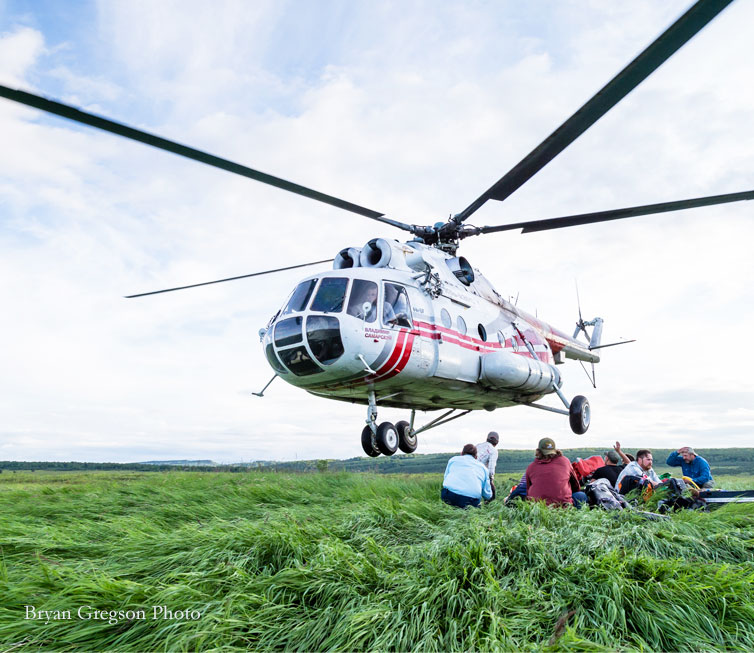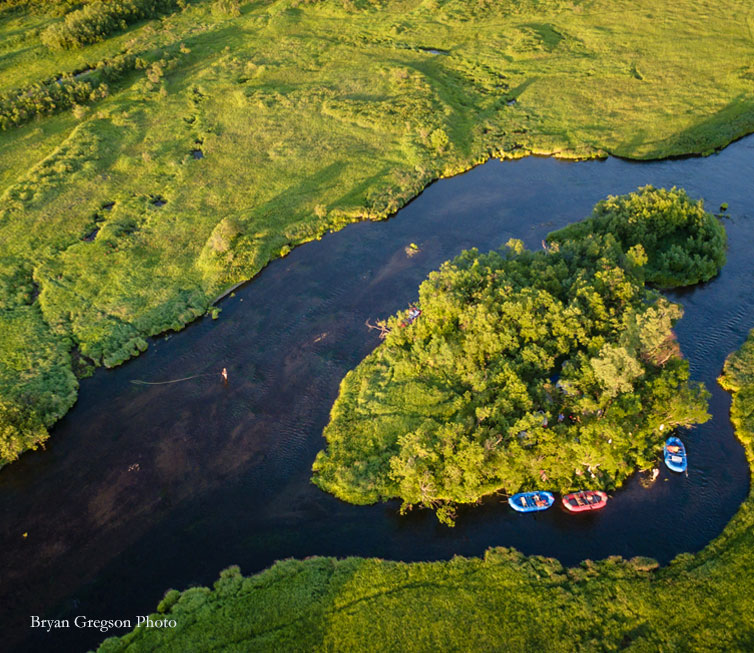The Northern Wilderness Floats in Kamchatka are easily the least-fished rivers in the world! We have a series of six different streams in this region, each one fished only once, at most twice a year. This ensures that every fish in the river has probably never seen an artificial fly, let alone been hooked. It is the most wild fly fishing experience on the planet!
We first began exploring a series of rivers in the far northern region of the Kamchatka Pensinula in the late 1990s. The river systems culminate in the massive Tigil River, and feature a handful of tributaries, both large and small, including the now-famous Sedanka Spring Creek, Turuscheva, several different forks of the Pirozhnikova and the Perevalovaya. These upper headwater streams bubble up from the toe of an ancient lava flow on Kamchatka’s northwestern taiga plains. These are THE most remote rivers in Kamchatka, and probably the entire world.
It is one of the most biologically diverse drainages on the peninsula, with all 6 species of Pacific salmon (including Cherry Salmon only found in the Far East), rainbow trout, resident kundzha, and sea-run dolly varden, both of the latter being species of char. This spring creek ecosystem is particularly rich with insect, mouse, and salmon biomass that feed an exceptionally dense population of 16-27 inch native rainbow trout. Sedanka was the first of these rivers discovered by The Fly Shop’s owner, Mike Michalak, in 1998 and has proved to be a fly fishing destination of incomparable beauty and excitement. As a bonus to the incredible fishing, these rivers do not “blow out” except in the absolute worst extended rain storm conditions, owing to the spring-fed origins and expansive lava rock in the drainage. These rivers are extremely stable.
In addition to the Sedanka, we continue to explore a series of other rivers in this drainage – and even different forks and branches of the Sedanka – each season through our northern river wilderness floats.
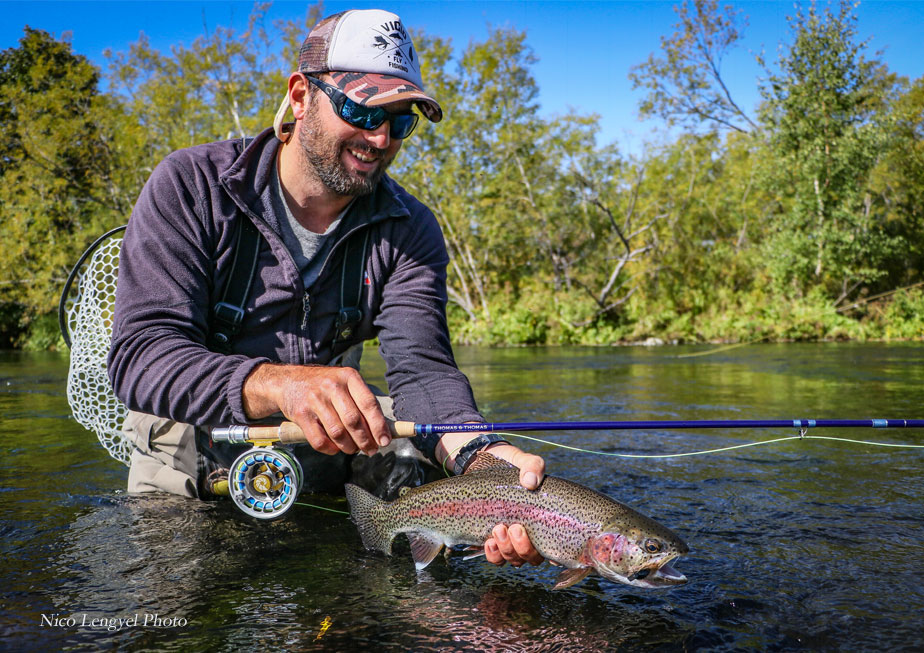
Reservations & Rates
The cost of the week-long Wilderness Float package is $7,495.00 USD per person (6 nights / 5 days) or $12,195.00 USD per person (Wilderness Float/Sedanka special itinerary - 12 nights/11 days)
• Kamchatka, more than any destination in the world, attracts adventurous single anglers. There is no surcharge to come alone. What's more, many people opt for multiple-week trips. In this scenario, the Wilderness Float Trips can easily be combined with the Sedanka Spring Creek Camps at significant savings.
Inclusions
Included in your angling package at the Wilderness Floats are all ground and air transportation once in Kamchatka and all food, accommodation and guides once at camp.
Non-Inclusions
Not included in your angling package at Wilderness Floats are airfare and travel expenses from your home to Kamchatka, Russian visitor's visa, fishing gear, flies, fishing license, medical evacuation insurance (required), and alcohol.
Travel Insurance
The Fly Shop® is not in the insurance business, but we recommend Travel Guard coverage as a service with a desire to see your best interests protected. It is impossible to know when an unfortunate situation (loss of luggage, fly rods, illness in the family, or an accident) may occur. However, such things can and do happen, and this insurance can provide a means of recourse against non-refundable financial losses.
• Travel Insurance Information
Seasons at Kamchatka Wilderness Floats
We tend to schedule Exploratory Expeditions during the most weather and water-stable weeks of late July through early September.
We monitor river conditions throughout the season and maintain the flexibility to take advantage of localized weather. Though the terrain,
Read More
topography and hydrology can be different from river to river, by and large the fishing methods and climactic conditions are uniform across the peninsula.
July:
The warmest month of the year in Kamchatka with day time temperatures usually between 60 and 80 degrees. As such, this is the peak dry fly fishing time with often heavy the mayfly and caddis hatches. It's a sight to behold to float silently around a bend and be confronted with 50 trout noses puncturing the smooth surface of the river in elegant head-dorsal-tail rises. Trout feed exclusively on bugs, mice and salmon smolt, and representative fly patterns all work well. Present as always are also kundzha (white spotted) char. Being the warmest month, July is also mosquito season. Most people find the trade-off worth it for the surface fishing opportunities, but if you have a low mosquito tolerance level, consider a trip later in the season.
August:
The middle of the season. The salmon enter the river and the full cycle of life is laid out in full magnificence. rainbows are targeted with mouse and streamer flies, and dry fly fishing is often found in the evenings. Some river systems may hold runs of silver (coho) or other salmon, and most have solid runs of dolly varden. By the middle of the month, biting insects are gone completely.
September:
Fall in Kamchatka. It can be chilly, in the 50-degree range. And with sunny weather can come frosty nights. It is also the most photogenic time of year to be amid the sub-arctic taiga and tundra foliage as it turns to blazing yellows, reds and oranges with a backdrop of snow-capped volcanoes. Trout are easily taken with surface skaters like mouse and floating baitfish patterns. Salmon are in full spawn in late August and September. Literally millions of fish bring the river completely alive. It is an overpowering sensory experience to see an ecosystem so healthy and pristine. Important to note also is that trout in Kamchatka do not get "tunnel vision" for salmon eggs as they do in Alaska, so no need for egg patterns, beads, split shot and strike indicators. Mice, streamers, dry flies and a floating line is usually all you need.
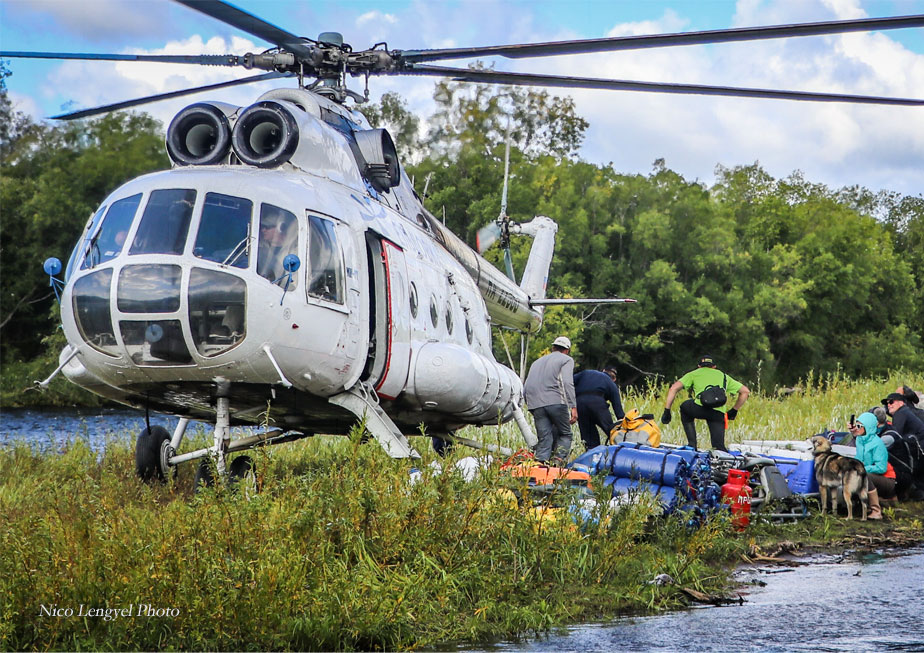
Getting to Kamchatka Wilderness Floats
There are a few different ways to get to Kamchatka, depending on the season.
Direct Flights Via Alaska: For a few weeks each summer, there is a weekly direct flight from Anchorage, Alaska to Petropavlovsk, Kamchatka.
Via Moscow or Seoul: There is a daily flight from Moscow that arrives at 10:00 am to Petropavlovsk, as well as a daily flight from Vladivostok (via Seoul) that arrives at 8:40 am. It may be possible to arrive the same day of your scheduled departure to the river, AS LONG AS YOU ARRIVE NO LATER THAN 10:00 AM.
Read More
However, we strongly recommend arriving a day early. This allows a chance to acclimate to the time change, so you’re not a vegetable when you arrive to the river. It also allows for any possible lost luggage or airline delays. If you miss the helicopter departure into camp, you will either miss your entire week of fishing or have to charter a very expensive extra helicopter flight into camp!
If you do plan on arriving a day early (recommended), please let us know as soon as you make your flight reservations so that we can work with our local partners in Kamchatka to arrange overnight lodging for you.
For overnights in Petropavlovsk, guests will typically be housed at one of Martha Madsen’s cozy guest houses in Yelisovo, or the Art Hotel near the airport. Nightly lodging fees (not included in your fishing package), range from $60-$100; guests are typically accommodated in double occupancy, but pending availability single rooms can sometimes be arranged by special request. The Fly Shop will make the reservations for you, and you will be able to settle up upon arrival.
Transfer to Camp:
All guests heading into the float will be met in the morning by Anatoly or Daria at your place of lodging (they will communicate the time with you the night before), or at the airport if you are arriving that morning. They will ask to see your Russian Immigration card (provided on the flight over) to register you with the government (mandatory for all visitors). This will only take a moment. If you have not sent the $100 Fishing License fee or a scanned copy of your passport to The Fly Shop in advance of the trip, they will also request these items upon arrival.
The first few hours in Kamchatka are always an exercise in patience. Understand that this is Russia, and communication from the helicopter companies is often lackluster at best. Keep in mind that the outfitters want you to get into camp as much as you do, and they are often at the whim of the helicopter companies. Everyone’s priority is to get you into camp safely, and as quickly as possible given the weather conditions.
Mornings in Petropavlovsk are frequently foggy, and the helicopters cannot fly until the fog clears. If the weather is clear in the morning, you will head straight to the heliport. If it is foggy but the forecast is for the weather to clear, the ground crew will find a way to kill some time while waiting for weather clearance from the helicopter companies. They may take you to a nearby store, partly to pass the time and partly so you can purchase souvenirs or booze/wine/snacks for your week in camp. They may also take you to the nearby Old Castle Restaurant, which has very good food (and local draught beer). Lunch and/or drinks at the restaurant are not included in the package price, but typically range from $20-$30. They do not accept US dollars, but one of the Kamchatka Trophy Hunts staff will be on hand to help trade dollars for Rubles.
As soon as the fog lifts and the pilots give weather clearance, you will board the bus for the 30 minute drive to the heliport on the outskirts of Yelisovo. If the weather looks like it will stay fogged in near Petropavlovsk for most or all the day, the best option to get you into camp may be a long bus ride (6.5 hours) north up the peninsula to the town of Esso, where there is another heliport closer to the river. There is only one mountain pass between Esso and the northern rivers, so often if you cannot fly from PK because of the weather you may be able to get out to camp by flying from Esso instead. It’s all part of the adventure of Kamchatka, and our outfitters will do everything they can to get you into camp and fishing as soon as possible!
In very rare circumstances, the weather can be so bad that the helicopters cannot fly at all. This happens an average of less than once per season, but it can happen and we don’t want our guests to be surprised if it does. If the helicopter cannot fly, the outfitters in Russia will find a suitable place for the entire group to say, usually either a cozy guest house in either Yelisovo or Esso. Weather-related delays are not the outfitters’ liability, and any meals or lodging associated with such delays will be your responsibility. If you have trip insurance, they will usually reimburse you for weather-related expenses, including meals and lodging, so be sure to save your receipts.
Once the pilots are cleared to fly, you will load your bags onto the Mi8 helicopter and lift off. Sometimes head sets are provided, but this is Russia and you never know so it is recommended that you bring some earplugs for the noise of the rotors. The flight will take you over countless rivers and streams, and past several volcanoes. From Yelisovo, the helicopter will travel north up the central Kamchatka Valley for approximately 1 hour and 20 minutes, before stopping to refuel either in Esso or Anavgai. Esso is a small town built around a series of hot springs; Anavgai is a tiny outpost in a small vale nestled in a mountain pass. Either location provides a 15 minute window to stretch your legs, go to the bathroom (you will want to find a bush on the edge of the heliport, as the outhouse is pretty nasty), take some pictures, then re-board the helicopter for the next leg of the flight. From either Esso or Anavgai, you should expect about 45-50 minutes more flight time before landing.
Sometimes the helicopter will drop the Sedanka group off at Camp 1 first before continuing on to drop the Float group off on their wilderness river; other times the wilderness float group will be the first to set foot next to the river. Either way, keep an eye on all of your personal bags to make sure they stay with you, and don’t inadvertently end up with the wrong group.
Upon landing, the crew and guides will unload the helicopter, and as soon as the Mi-8 takes off the crew will begin setting up camp while you can rig up your gear, don your waders, and start fishing!
5.5+ Full Fishing Days:
Wilderness expeditions are based around a loose daily schedule of breakfast at 8 a.m., followed by camp breakdown and on the river by 9 a.m. The angling days are long, while the weather can range from warm and comfortable to cold and wet (be prepared for either eventuality!). Each day is spent floating and fishing (two anglers and one guide per raft), stopping for lunch and eventually setting up a new camp each evening around 7 p.m. Every hour of the day will be an adventure! The after-angling campfire sessions always include traditional Russian toasts to the successes and most dramatic moments of the day. A cook and camp assistant travel in a separate raft and do the large majority of “camp work.” Each pair of anglers are responsible for maintaining their own tent and inflatable sleeping mattresses. All camp equipment – except your sleeping bag - is provided as part of the trip. You must bring your own sleeping bag.
Returning Home:
On the final morning, guests have time to dry clothes and waders, re-pack their bags, and prepare for the trip home. The guides and camp staff will break down camp and deflate the rafts to be ready for the helicopter, but if you want to fish this last day there is time in the morning for several more hours of fishing around camp. The head guide will also come around at this time to collect any gratuities you may wish to leave for the guides and staff for the week.
The helicopter will most likely arrive sometime between 11:00 am and 3:00 pm (depending on weather clearance), and will transfer you back to Petropavlovsk.
You will typically need to overnight in Yelisovo, unless departing on the weekly flight to Anchorage, as most of the departing flights through Moscow or Vladivostok/Seoul take off in the morning. There are some afternoon departures, but due to the un-predictable timing of the helicopter flights out of camp, the outfitters cannot guarantee they can get you back to town in time to catch those afternoon flights. The Fly Shop will help make these arrangements for you (not included in the package price), and you can settle up prior to departure at the hotel.
Anatoly or Daria will meet you again and transfer you to the airport. If there is time, the bus can also take the group to a nearby store for souvenir shopping. Anatoly will get everyone the departure paperwork at this time, which you will need to present along with your passport and visa at Immigrations when departing Russia.

Lodging at Kamchatka Wilderness Floats
Kamchatka Wilderness Floats are the most rustic, adventurous trips on the peninsula… maybe the world.
That being said, we've controlled all the factors that are controllable by outfitting the expeditions with hi-tech 4-season mountaineering tents and specialized cooking and camp equipment in use on professional river trips
Read More
in the Rockies and Andes. For convenience of communication on the river, and for a safety line to the outside world, each expedition is further outfitted with first aid kits, GPS, handheld radios and a satellite telephone.
Each morning the three fishing boats head down stream and spread out to avoid "double fishing" any one section. Meanwhile the cook and camp assistant break down the camp and float on ahead of the fishing boats. Toward evening the forward boat selects a camp site and begins erecting camp. Anglers are responsible for setting up their tent and sleeping arrangements (two people per tent.)
Staff does all the cooking, cleaning, etc., while you fish until dinner or crack a cold beer by the fire.
Food on our Wilderness Floats is typically very good and plentiful, with the cook utilizing the same fresh, diverse ingredients that our permanent camp kitchens use.
Beer and Vodka are available for sale, but other or special libations need to be brought from the United States.
This is the most hard-core trout fishing trip most people will ever sign up for, but there are no objective whitewater hazards. The most uncomfortable situations encountered on these trips is rain, so it is imperative that all your luggage be made of completely waterproof material.
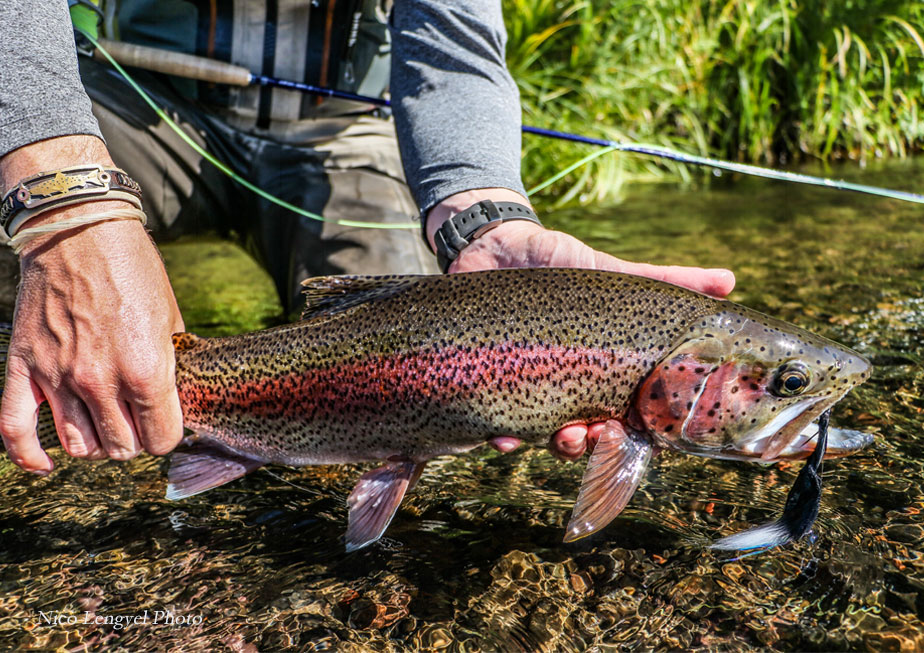
Fishing at Kamchatka Wilderness Floats
Wilderness Floats are based around a schedule of floating and fishing each day and establishing a new tent camp each evening.
We've found that the ideal distance to explore in 6 days is between 30 and 40 miles. This offers lots and lots of fishing time and leaves no section of the river untested or under explored. With long daylight hours
Read More
there is plenty of flexibility pre-built into the trip. Flexibility is the key to success when stepping into the unknown.
After a midday arrival by helicopter to the put-in spot, you will be able to instantly gear up and fish by foot on the immediately adjacent river. As you do, guides and staff inflate the rafts and orgainize camp gear. Depending on your arrival time, you may float and fish for a few hours before setting up camp, or you may establish camp at the Helicopter LZ.
Basic Itinerary:
• Coffee & Tea at 7:00 am
• Breakfast at 8:00 am
• On the water by 9:00 am
• Lunch on the river midday
• Establish new river camp and dinner at 8:00 pm
• Cocktails, campfire and fish stories close out the day. Or, for midnight-sun junkies, the river is always within casting distance from the fire pit. In addition to 6 anglers, other Expedition members consist of 1 Professional Western Guide, 2 Russian guides, a cook and a camp assistant. Our staff is specifically selected for these intense trips for their expedition expertise, and personal interest in walking on the wild side. The same crew has been working together on our Exploratories for many years. They have it dialed.
There are three fishing methods that you're likely to employ when probing virgin water:
Mouse:
Real mice slip and fall into the river from overhanging limbs and grass and then swim like a cork at a down-and-across angle. As they swim, they throw small V-wake contrails off their back end which the trout key to. Anglers replicate this action by plopping their flies against the opposite bank and skittering them across the river, on tension and under control. What follows has got to be the most exciting thing in freshwater flyfishing. Since a live mouse in the stomach of a rainbow trout can do some damage, they tend to take the fly with a ferocious, bone-crushing chomp with the intention of killing the mouse before they swallow it. This behavior is obviously on the surface, totally visible to the angler. The skill comes in controlling your nerves to NOT set the hook when the fish merely swirls behind it - sometime 2, 3, 4 or more times - before actually committing.
Dry Fly:
Traditional floating line and size #10-18 gray bodied caddis and mayfly imitations are used with staggering success on the Sedanka, especially in July, less so in August, and again quite successfully in September. The fish tend not to be picky on the specific pattern. However, with so much food floating past their feeding lies, it is sometimes critical to deliver a reasonably accurate and truly dead drifted presentation. If the fly floats within an inch or so of the trout's nose the chances of it rising are very good.
Streamer:
Salmon smolt and other juvenile fish make up a significant portion of Kamchatka trout and chars' diets. Clousers, woolly buggers, string leeches, baitfish and sculpin patterns all work very well on the Sedanka throughout the season. Small fish elicit a chase response from their predators, so often it is best to give the fly a little movement as it swings through the water column. And like with the mouse, it's best to learn to identify likely structure in the river (tree roots, riffle-pools, rocks, undercut banks, etc.) that offer rest areas for the fish adjacent to heavier currents where they can surprise-attack their food.
Fly Selections:
We offer a great Fly Selection option for all of our Kamchatka destinations. These selections are NOT generic, pre-packaged fly selections. Every specialty fly selection from The Fly Shop is personally selected by one of our travel experts that have fished these destinations not just once but a bunch of times.
Why We Endorse This Destination:
Kamchatka Wilderness Floats
• For those anglers with adventure in their souls, look no further than the Northern Wilderness Floats in Kamchatka. These are the most off-the-grid, remote, trout streams in the world. Period.
• We use a series of small tributary streams and spring creeks, rotating each so that no stream is floated or fished more than once or twice a year. These are the most unpressured, wild trout streams in the world, and a rare opportunity to experience fish behavior in a place where every fish will likely move to your fly...because they’ve never been hooked before.
• The super-remote rivers in northern Kamchatka offer the most consistent mouse fishing in the world. Many of our guests fish nothing but a mouse all week!
• These rivers have an almost unbelievably high population of trout. Every riffle, boulder, pool, logjam, and bend in the river is likely loaded with rainbow trout, looking to attack skated mouse pattern or streamer. It’s a safe bet you’ll catch more fish on an average day on these rivers than many of us catch in a week on our favorite trout stream at home.

